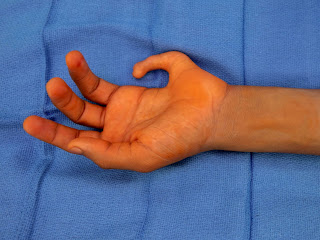A patient with a thumb and three normal fingers has a hand that functions at a near normal level and looks great. The narrow hand caused by a lack of a single finger (as long as the others are well aligned and no significant gaps exist) is not easily detected by others- it looks good.
The choice to remove an abnormal finger in a child is never easy. All of us have a tendency to want to maintain all the fingers even if one is notable abnormal. The issues of appearance and of function must be considered. A finger that looks different that does not interfere with function is very different than a finger that interferes with function. To me, a finger that interferes with function is one that should be reconstructed and if it cannot be reconstructed, it should be removed.
Sometimes families prefer that the child play a part in the decision- making on digit removal. I understand this concept but families should understand that most children will need to be at least 10 years of age before that type of decision- making can realistically take place.
Another scenario is around eastern cultures that prioritize a hand with 5 of digits. To those in Japan or China, the abnormal finger should be reconstructed due to the extreme priority of keeping all digits. This is true even if the finger does interfere with function.
Consider this patient. His abnormal finger was kept in place until he decided, as a teenager, that it was getting in the way. It was caught on things and simply interfered with activities. At first glance, this looks like a very abnormal extra digit. In reality, this is a very rare form of cleft hand with a deep cleft between the ring and little finger and with an abnormal little finger After much thought and discussion, the patient requested excision and has been very, very pleased with the functional improvement and appearance.
 |
| Patient with ulnar cleft hand with very abnormal 5th finger. The thumb is not visible in this picture. |
 |
| Another view of abnormal fifth finger in ulnar cleft hand. |
 |
| Patient after removal of abnormal finger in ulnar cleft hand. |
 |
| Patient with abnormal 5th finger removed in ulnar cleft hand. The palm is narrow. |
The hand is narrow and small through the palm. The wrist is wider than the palm. Nonetheless, the hand has been functioning better and certainly looks improved compared to function and appearance before the surgery.
email: congenitalhand@wustl.edu
Please CLICK HERE to support our research.
Designate my name. Thank you!

